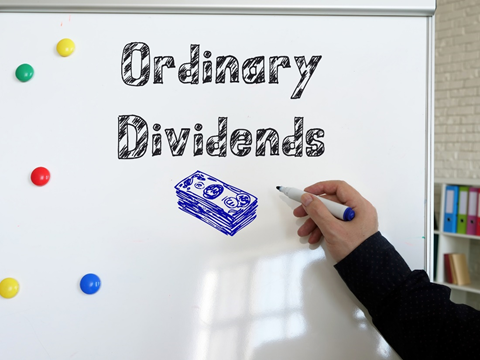Qualified Dividend
Updated on 2023-08-29T11:55:38.851545Z
Dividends that fall under the capital gains tax rate are known as a qualified dividend. Taxation on dividends at capital gains rate is more advantageous than the ordinary dividends taxed as ordinary income tax rates. This is because the maximum tax rate for capital gains is 20%, while the maximum ordinary tax rate is as high as 37%. In addition, the Internal Revenue Service (IRS) has set specific criteria that a dividend must fulfil to be taxed at long-term capital gains tax rate.
Therefore, depending on the tax slab, the qualified dividend is taxed at any of the three different tax rates, i..e 0%, 5% or 20%.
Summary
- Dividends that fall under the capital gains tax rate are known as a qualified dividend.
- Taxation on dividends at capital gains rate is more advantageous than the ordinary dividends taxed as ordinary income tax rates.
- The maximum tax rate for capital gains is 20%, while the maximum ordinary tax rate is as high as 37%.

Image Source: © Rummess | Megapixl.com
Frequently Asked Questions
How are Qualified Dividends taxed?
Regular dividends are divided into two categories—ordinary dividends and qualified dividends. Since the rate at which these two dividends are taxed is different, they impact an investor’s net returns. For example, for those investors whose ordinary income is taxed at 10% or 12%, the tax rate on the qualified dividend is 0%. However, for a taxpayer who pays the income tax rate exceeding 12% to 35%, the qualified dividend is taxed at 15%.
Moreover, for individuals who fall in the tax slab of 35%-37% and with ordinary income over $434,551, the tax rate on the qualified dividend is kept at 20%. These tax rates are according to the 2019 calendar year. One should also note that an extra 3.8% Net Investment Income Tax (NIIT) is pertinent for investors who are married taxpayers (file their taxes jointly) and who have over $200,000 or $250,000 as their modified adjusted gross income.
In the US, Form 1099-DIV mentions dividends and certain other distributions to investors or taxpayers. In this form, box 1b contains the list of qualified dividends. This form is provided to the investors who receive distributions during a financial year. Box 1a of the Form 1099-DIV contains ordinary dividends.
To qualify for the long-term capital gains tax rates of 0%, 15%, or 20%, qualified dividends must fulfil specific criteria, as outlined by the IRS:
- An investors/ taxpayer's dividend must be paid by a US corporation or a qualifying overseas company.
- The dividend must fulfil the holding period requirement. This means that an investor must own the applicable share or own the stock for over two months during the 121-day period that starts 60 days ahead of the ex-dividend date. However, it is to be noted that for specific preferred stock, the investor must own the security for 91 days out of the total 181-day period, starting 90 days ahead of the ex-dividend date.
What is the difference between Ordinary and Qualified Dividend?
Though there is little difference between qualified and ordinary dividends, they significantly impact an investor's overall returns. Most of the regular dividends distributed by US companies belong to the category of qualified dividends.
As discussed above, the most fundamental difference between qualified and unqualified dividends is the tax rate. Ordinary dividends are taxed at an individual’s regular income tax rate, whereas qualified dividends are subject to favourable tax rates. Because of the considerable tax differential between these two forms of dividends, investors should hold dividend-paying shares for more extended periods, allowing them to keep a far larger amount of their dividends.

Image Source: © Rummess | Megapixl.com
Which all dividends are considered as non-qualified dividends?
The dividends which are exempt from being considered as a qualified dividend are:
- The dividends which are paid by real estate investment trusts (REITs)
- Dividends payouts by master limited partnerships (MLPs).
- Dividends that come from tax-exempt companies.
- Dividends that are paid on ESO (employee stock options)
- Bank dividends or a shareholder dividend from a bank or credit are treated as interest income and not treated as actual dividends.
Besides, qualified dividends must come from shares that are not associated with hedging. A foreign company is exempt from qualified dividends if it is regarded as a passive foreign investment company.
What is the holding period requirement for a Qualified Dividend? Give an example.
For a dividend to be taxed as capital gains tax rate, it must fulfil the holding period requirement. This means that an investor must own the applicable share for over two months during the 121-day period that starts 60 days ahead of the ex-dividend date. However, it is to be noted that for specific preferred stock, the investor must own the security for 91 days out of the total 181-day period, starting 90 days ahead of the ex-dividend date.
Example:
Suppose an investor Alfred receives qualified dividends from shares in XYZ mutual fund. Alfred purchased 1,200 shares of XYZ mutual fund on May 1 for a particular calendar year. However, after few days, Alfred realizes that he needs some money, and thus, he decides to sell few shares. On June 1, Alfred sells 200 of those shares. In this way, he is left with the (unhedged) 1000 remaining shares. May 15 was the ex-dividend date for these funds.
Here we see, in this duration of 121 days, Alfred owned 200 shares for 31 days and the remaining 1,000 shares for at least 61 days. This suggests that the dividend income gained from the 1,000 shares that Alfred owned for at least 61 days would be regarded as qualified dividend income. In contrast, the income earned from the 200 shares for only 31 days would be ordinary dividend income. Hence, Alfred can use the qualified dividend per share price for tax reporting purposes to obtain the absolute amount of qualified dividends.